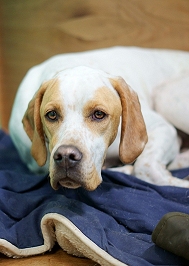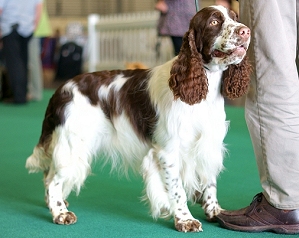

Gundogs



Gundogs are generally classified using the following terms (referring to their function):
Pointer - breeds which "point" out game to the hunter, usually by raising a foreleg.
Setter - breeds which "set" or sit when they locate game.
Spaniel - breeds which flush out game.
Retriever - breeds which retrieve game.
Water Dog - breeds which retrieve specifically from water.
However, many gundog breeds are able to perform more than one function, for example spaniels will generally flush and retrieve, so sometimes their names are somewhat misleading. Truly multi-purpose gundogs are known as hunt-point-retrievers (HPRs).
There is also a small group of breeds known as "decoy dogs" (Kooikerhondje and Nova Scotia Duck Tolling Retriever). These were bred to lure ducks into range, generally by playing or causing a disturbance at the water's edge.

History
The gundog group contains many more modern breeds, developed with the advent of the shotgun. However, tracing their ancestry is not easy, as most gundog breeds bear very little similarity to dogs from other groups.
It is known that pointers descend from Spanish and Italian scenthounds, with the Bracco Italiano and Perdiguero de Burgos being the most ancient types. Spanish pointers were imported to Britain in the 1600s, and bred with other breeds such as the Greyhound, producing the more elegant breeds seen today. Wire-haired pointers may descend partly from the Italian Spinone, which is more or less a rough-coated version of the Bracco Italiano.
Spaniels probably descend from the Spanish Water Dog or the Lagotto Romagnolo, which in turn are thought to have been bred from herding dogs (of a type similar to the Bergamasco). The original spaniels resembled today's curly-coated water dogs, such as the Barbet, and land spaniels (with straighter coats) were bred later. Some of the larger spaniels were crossed with pointers to create setters.
The history of retrievers is the most murky of all, but all appear to descend from the St. John's Water Dog, a Canadian breed most likely bred from dogs imported from Europe, and resembling today's Labrador Retriever. The longhaired dogs were bred with mastiffs to create the Newfoundland, and taken back to Britain in the 1800s to create the British retrievers - the Flat-coat, Golden and probably the Curly-coat. The shorthaired dogs became the Labrador and Chesapeake Bay Retriever.

Distribution

(the different shades represent the number of gundog breeds originating from that country, with the lightest shades representing the least amount of breeds and the darker shades representing the most)
As we can see from the map, gundogs originate exclusively from Europe and North America. This is mainly due to all gundogs descending from just a few European ancestors, which spread around Europe and to Canada, but did not reach Asia, Africa or South America. There are one or two breeds from those continents which fulfil similar roles to gundogs, but in general there is little use for them. As the most modern of the "useful" dog groups, gundogs are probably some of the breeds most removed from the wolf, in instinct as well as genetics, and so have only been developed in areas where a lot of selective breeding of dogs has taken place - namely Europe and North America. Also, the use of gundogs is very much a cultural thing, as they are, in general, intended to hunt birds, often simply for fun or sport. The recreational hunting of wildfowl is most common in the Western world.

| Breed name and picture | Liver | Dilution | Sable | Tan points | Agouti | Brindle | Recessive Red | Merle | |
|---|---|---|---|---|---|---|---|---|---|
|
|
|
|
|
|
|
|||
|
|
|
|
|
|
|
|
|
|
|
|
|
|
|
|
|
|
|
|
|
|
|
|
|
|
|
|||
|
|
|
|
|
|
|
|
|
|
|
|
|
|
|
|
|
|
|
|
|
|
|
|
|
|
|
|
|
|
|
|
|
|
|
|
|
|
|
|
|
|
|
|
|
|
|
|
|
|
|
|
|
|
|
|
|
|
|
|
|
|
|
|
|
|
|
|
||
|
|
|
|
|
|
|
|
||
|
|
|
|
|
|
|
|
|
|
|
|
|
|
|
|
|
|
|
|
|
|
|
|
|
|
||||
|
|
|
|
|
|
|
|||
|
|
|
|
|
|
|
|||
|
|
|
|
|
|
|
|||
|
|
|
|
|
|
|
|
|
|
|
|
|
|
|
|
|
|
|
|
|
|
|
|
|
|
|
|
|
|
|
|
|
|
|
|
|
|
|
|
|
|
|
|
|
|
|
|
||
|
|
|
|
|
|
|
|
||
|
|
|
|
|
|
|
|
||
|
|
|
|
|
|
|
|
|
|
|
|
|
|
|
|
|
|
||
|
|
|
|
|
|
|
|
||
|
|
|
|
|
|
|
|
||
|
|
|
|
|
|
|
|
||
|
|
|
|
|
|
|
|
||
|
|
|
|
|
|
|
|
||
|
|
|
|
|
|
|
|
||
|
|
|
|
|
|
|
|
|
|
|
|
|
|
|
|
|
|||
|
|
|
|
|
|
|
|
|
|
|
|
|
|
|
|
|
|
|
|
|
|
|
|
|
|
|
|
||
|
|
|
|
|
|
|
|
|
|
|
|
|
|
|
|
|
|
|
|
|
|
|
|
|
|
|
|
|
|
|
|
|
|
|
|
|
|
|
|
|
|
|
|
|
|
|
|
|
|
|
|
|
|
|
|
|
|
||
|
|
|
|
|
|
|
|
|
|
|
|
|
|
|
|
|
|||
|
|
|
|
|
|
|
|
|
|
|
|
|
|
|
|
|
|
|
|
|
|
|
|
|
|
|
|
||
|
|
|
|
|
|
|
|
||
|
|
|
|
|
|
|
|
||
|
|
|
|
|
|
|
|
|

Some Notes on Gundog Colour Genes
From the table we can see that the liver gene is very widespread in gundogs. The main breeds which lack the liver gene are the ones which have been specifically bred to come
only with black pigment, showing that liver has been present in most, if not all, gundog types since breeding began.
Brindle and merle are entirely absent, and dilution is present in only
a handful of breeds. Dilution is present in the Slovakian Pointer due to its Weimaraner ancestry, but how did the Weimaraner get this gene? It is possible that it is
due to mastiff blood - probably from the Great Dane or similar. Dilution is certainly absent from all other pointers, and from spaniels and setters too.

